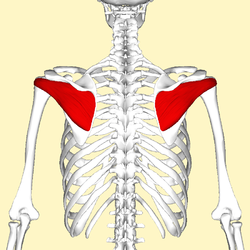ARTICLE ON ANATOMY, MUSCLES OF THE UPPER LIMB (INFRASPINATUS)
INTRODUCTION
In human anatomy, the infraspinatus muscle is a thick triangular muscle, which occupies the chief part of the infraspinatous fossa. As one of the four muscles of the rotator cuff, the main function of the infraspinatus is to externally rotate the humerus and stabilize the shoulder joint.
Structure
 It attaches medially to the infraspinous fossa of the scapula and laterally to the middle facet of the greater tubercle of the humerus.
It attaches medially to the infraspinous fossa of the scapula and laterally to the middle facet of the greater tubercle of the humerus.
The muscle arises by fleshy fibers from the medial two-thirds of the
infraspinatous fossa, and by tendinous fibers from the ridges on its
surface; it also arises from the infraspinatous fascia which covers it, and separates it from the teres major and teres minor.
The fibers converge to a tendon, which glides over the lateral border
of the spine of the scapula, and, passing across the posterior part of
the capsule of the shoulder-joint, is inserted into the middle
impression on the greater tubercle of the humerus.
The trapezoidal insertion of the infraspinatus onto the humerus is much
larger than the equivalent insertion of the supraspinatus, the reason
why the infraspinatus is involved in rotator cuff tears about as
frequently as the supraspinatus.
| Origin | infraspinous fossa of the scapula |
|---|---|
| Insertion | middle facet of greater tubercle of the humerus |
| Artery | suprascapular and circumflex scapular arteries |
| Nerve | suprascapular nerve |
| Actions | Lateral rotation of arm and stabilizes humerus |
Relations
The tendon of this muscle is sometimes separated from the capsule of the shoulder-joint by a bursa, which may communicate with the joint cavity.
Innervation
The suprascapular nerve
innervates the supraspinatus and infraspinatus muscles. These muscles
function to abduct and laterally rotate the arm, respectively.
Variation
The infraspinatus is frequently fused with the teres minor.
Function
The
infraspinatus is the main external rotator of the shoulder. When the arm
is fixed, it abducts the inferior angle of the scapula. Its synergists
are teres minor and the deltoid.
The infraspinatus and teres minor rotate the head of the humerus outward (external, or lateral, rotation); they also assist in carrying the arm backward.
Additionally, the infraspinatus reinforces the capsule of the shoulder joint.



Post a Comment